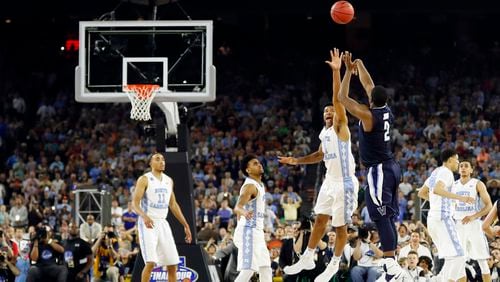The NCAA Tournament is a great thing. It’s also three different things, which is the chief reason it’s great. It’s win-or-else, which the NBA playoffs aren’t. The baseball playoffs aren’t, either. (Unless you count wild card games, which you probably shouldn’t.) The NFL postseason and the College Football Playoff are one-and-done, but there are no Stephen F. Austins in those.
Unlike the other dances, the Big Dance evolves. It officially commences with the First Four in Dayton, but for the masses it starts at noon on Thursday. That’s the day we skip work to binge-watch, but that day isn’t like, say, Final Four Saturday. That decades-old CBS slogan, “The Road to the Final Four”? It speaks the truth. We remember the destination — meaning the winner — but we come for the journey.
Act 1: The bracket is all.
In 2015, the American Gaming Association estimated that 40 million folks submitted 70 million brackets in some sort of competition. We note that Nielsen ratings held that 28.3 million — the highest number over the past 19 years — watched the 2015 NCAA championship game. This tells us what we already know: Days One and Two of the tournament, the Thursdays and Fridays, draw an audience that doesn’t follow college basketball much beyond Days One and Two, whereupon those disgruntled souls wad up their brackets and turn away.
That doesn’t make the tournament a bad thing. On the contrary, it makes it a unifier of Americans in a way that almost nothing unifies us anymore. We watch Rounds One and Two — especially Round One — in the hope/expectation that we’ll see something we never expected. That we’ll see Mercer over Duke, Georgia State over Baylor, Middle Tennessee State over Michigan State. We’ll learn where Stephen F. Austin is located. (Hint: Not in Austin.) We’ll have a spring fling with an object of our affection that we’ll never see again.
For all the great days in the history of the NCAA, most observers point to March 14, 1981, as the day the Dance started to swing. In the span of two hours, a national audience saw St. Joseph’s fell No. 1 DePaul on John Smith’s broken-court layup; Arkansas’ U.S. Reed stun reigning champ Louisville on a halfcourt fling and, then, seconds after Reed’s immortal bucket, Rolando Blackman of Kansas State hitting from the corner to oust No. 1 seed Oregon State. The latter two moments were the finest hour for what NBC, in its final season of NCAA coverage, called its “whip-around.”
With every game now being aired live — and not just on TV; on tablets and phones — the tournament’s first four days (again, not counting the First Four) are one long whip-around. They’re so dizzying they wear you out. A confession: I’m more tired after an NCAA Thursday at home than if I’m covering a sub-regional on site, because in the latter case I mostly watch what’s in front of me. If I’m just being a fan, I want to see everything.
The fun of the first week isn’t that our brackets hold — because almost none of them do. The fun is that they’re broken in such a way that we don’t care. Did you really want to root against Stephen F. Austin? You’d have liked it better if Ron Hunter’s son hadn’t hit the shot that made dad fall off his rolling chair? The tournament’s first week is about glorious chaos. But chaos eventually yields.
Act 2: Basketball replaces brackets.
The big stage of the Final Four sometimes leaves good teams gasping for air. (Sample score from last year’s national semis: Villanova 95, Oklahoma 51.) The regionals are different. Always every member of every Sweet 16 can really play and does. The best basketball is played there.
By the regional semis, the mystery guests are gone. Nine double-digit seeds won Round One games last year; seven were eliminated in Round Two. The exception: No. 10 Syracuse and No. 11 Gonzaga, neither of which could be deemed Davids among Goliaths. Since seeding began in 1979, only four double-digits have made the Final Four. Only two — George Mason in 2006 and VCU in 2009 — were mid-majors.
The point being: By the Sweet 16, the Stephen F. Austins have headed back to Nacogdoches, Texas. (There’s your answer.) Rarely do we get a blowout in the Elite Eight. Indeed, the game widely considered the best in tournament annals was Duke over Kentucky in the 1992 East Regional, and the very next day — in Lexington, Ky., of all places — brought one nearly as good: Michigan’s Fab Five over No. 1 seed Ohio State. And the nice part about the regionals is that four teams get to celebrate winning them. Only one team cries happy tears at journey’s end.
Act 3: A champion is crowned.
The tournament begins as an egalitarian place. Villanova plays Mt. St. Mary’s. Duke plays Troy. Kentucky plays Northern Kentucky. It ends with one team, one only, having had six chances to lose but having aced every test.
Sometimes the best teams fall short — Indiana in 1975, North Carolina in 1984, Kansas in 1997 and 2010, Duke in 1999 and 2002, Kentucky in 2015. That mightn’t seem fair, but it only adds to the allure of March Madness. No team wins this tournament because it looks good on paper.
From 68 to 64 to 32 to 16 to eight to four to two to One Shining Moment, all in the span of 21 days: It’s the best three weeks in American sports, every year, without fail. And here we go again.







